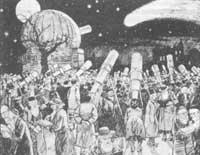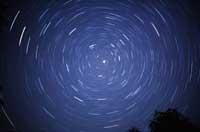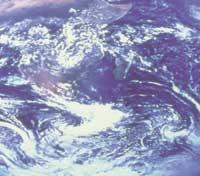Is the sky stable?
1995/03/01 Zabala Caballero, Eduardo Iturria: Elhuyar aldizkaria

The question we are going to ask this month is: Is heaven changing? That is, when in a moment we see the part of the sky or the sky, day and night, that we have seen a few minutes ago and that we will see in the next minutes, are they equal?
As often happens, how many people we answer or what kind of questions we answer. However, and to respond clearly and quickly, we will say that, although it often seems to us that the firmament is standing, it moves and changes constantly. These continuous changes will depend on the type and/or section of the stars we study.
In the following lines we will try to clarify and complete the previous answer. For this it is necessary to differentiate between question and answer.
Day

By day we see the blue sky. This is because the Earth's atmosphere blurs the light from the nearest star. Therefore, although we can see it with different shades depending on the place of observation and the position of the Sun, we will see the blue sky. If it is not cloudy, of course. But since the clouds are in the atmosphere, very close to us, they are outside our study area.
Imagine that the Sun is in the sky. Is he standing? Obviously not. If we take any reference (with a mountain or tree, or with the shade generated by any house or building) we will realize that the Sun moves quickly and relatively quickly. If in an instant we are looking, we will see that this movement is a movement from left to right.

Let's sharpen our question more. During the day the Sun moves, but every day comes out in the same place and gets in the same place? Does the Sun reach the same height every day? To answer these questions we must lengthen our visits over time. That is, throughout the year the Sun modifies the points of east and west and the point of maximum height. But since these changes are almost imperceptible, from one day to another it is difficult to realize it. There are weeks when you need to realize these differences.
From the cardinal point East, the Sun occurs only two days a year, coinciding with the beginning of spring and autumn, and only in those two days will enter the cardinal point West. The rest of the year is born in the East and simply enters the West. Since the beginning of spring the Sun is created and is becoming more and more north. As a result, more and more time passes in the firmament and reaches higher height to reach a maximum.

That day begins the summer, from June 21 to 22. In the following days, the East and West points of the Sun begin to approach the East and West cardinal points until the beginning of autumn (22-23 September). Then the Sun is increasingly to the South. Therefore, the Sun will stay less and less time above our horizon, so each time it will get a lower height to the minimum. The minimum will be the day of the beginning of winter, December 21 or 22. From now on the east and west points of the Sun begin to approach the East and West points, until the day spring begins (20-21 March). And the cycle begins again.
In any case, for its interest and relevance, it will later be analyzed and deepened in another article.
Night
The Sun is not on the horizon, we do not see its luminosity and the atmosphere “disappears”. Therefore, the firmament appears black, with the stars of the sky as points (as if there were no atmosphere). Unfortunately (this, including it in astronomical humor) remains in the atmosphere and astronomy fans and professionals know the obstacles and limitations it generates.

In this second box we must place arches to better analyze the problem.
The moon
As we have all learned, the Moon has phases and steps. That is, their appearance changes. Some days we can not see it, then it appears very thin and gradually it is rounded until it appears full. Then you start to lose weight until you disappear and a new cycle begins. We know that all this is based on the position between the Sun, the Earth and the Moon, but have we ever realized where we see the Moon? Can we always find ourselves in the highest part of the horizon or in the sky? If we follow up for a few days at the same time, can we say that it is always in the same place? Are the stars around you the same? Can you see the Moon by day?
The answers we give to all these simple questions indicate that the Moon, throughout its cycle, not only changes aspect, but also space.
Stars
Just look at the firmament, we will realize that we can create a lot of geometric figures. In these geometric figures, the ancients saw mythological characters, that is, constellations in the ancient sense.
Constellations move in two ways. On the one hand is the general movement they have one night, which is due to the rotation of the Earth. And the movement that occurs because the Earth revolves around the Sun throughout the year. This last movement makes the constellations appear in the firmament at different times (seen at night). Consequently, each station has its own constellations. 4,000 years ago the arrival of the station was predicted through the stars and later the Romans used the Great Bear as a night clock.
The third factor is the movement of the stars: the movement of each star, that is, the movement of translation of each star. Star speeds are very variable. Some move fairly slowly (speaking of astronomy) and others very quickly. In any case, this movement is invaluable, as they are far from us. Changes in distance between stars require long periods of time.

Planets
These are the night travelers! The ancient observers discovered that some stars that appeared between constellations were mobile and that day by day they changed their position with respect to the stars. Hence the name of planet. Planet in Greek means traveler. The largest planet was the Sun, followed by Mercury, Venus, the Moon, Mars, Jupiter and Saturn. Beside the stars of Huarte formed the 7 skies of the world.
Currently the concept of planet is modified. But amateur astronomers could only enjoy the beauty of these classic planets, because others are far away to observe our telescope.
The tours of the planets are very easy to follow through the sky every week. They move between the constellations and usually oppose the general movement (from east to west). But sometimes the outer planets stop between the stars and the general movement acts upon them. This singular movement is called retrogradation. As is known, all these movements are virtual. That is, every planet moves around the Sun, but as the stars are behind, they seem to move between them. It should be noted that the movement speeds of the planets are different. Some (inner planets) move very fast. Others, instead (outer planets) much slower.
Other “stars”

If the firmament is clean enough, we will easily see the three types of objects listed below. The most abundant, which we will see at any point in the firmament, are planes or planes. These move very fast and have two flashing light colors (green and red).
Similar to small stars, but other objects that move between them quite quickly and dramatically are artificial satellites. They are outside the atmosphere and under the sun. Although they are very small, we see them because they move among the stars. Therefore, we can only see and in no case see polar orbits, which are geostable. These words can be the essence of another article.
Finally, we will mention the light or fleeting stars that have offered us a show in several nights. In recent years, especially in summer, they are protagonists of the “star rains” that the audiovisual media have made fashionable. The Earth, along its trajectory, finds and attracts pieces of stone that are in space, which when entering the atmosphere turn red alive, offering a spectacular spectacle.
So, from now on, is the sky changing? when asked, we will answer correctly: Yes! But then let's explain what that means or what the different words of change mean, right?

Gai honi buruzko eduki gehiago
Elhuyarrek garatutako teknologia





